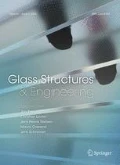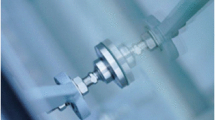Abstract
The present paper describes different types of experimental test setups to determine material properties of thin structural silicone used as laminated connections in glass structures. Since it is of major interest to conduct homogeneous experiments with structural silicones, which belong to the family of rubber-like materials, the triaxiality will be introduced, which allows one to illustrate differences between homogeneous and inhomogeneous experiments. With the help of this scalar, it is possible to design experimental test setups, which ensure a homogeneous stress and strain distribution within the tested rubber-like material. Furthermore an engineering approach to determine the testing speed of arbitrary experiments dependent on one reference testing speed and experiment will be presented. This approach ensures equivalent strain energies between arbitrary and reference test specimens during testing, by which expensive strain rate controlled experiments can be relinquished, since rubber-like materials exhibit a strain rate dependency. Based on this, homogeneous experimental tests were conducted: uniaxial tension and compression, biaxial tension as well as shear-pancake tests. Furthermore, microindentation tests as inhomogeneous tests were performed. Afterwards the experimental results were processed in a manner that it is possible to identify hyperelastic material parameters via standard fitting routines as well as inverse methods, which will be presented in part II of this publication.













Similar content being viewed by others
References
Ansarifar, A., Lim, B.: Reinforcement of silicone rubber with precipitated amorphous white silica nanofiller-effect of silica aggregates on the rubber properties. J. Rubber Res. 9(3), 140–158 (2006)
ASTM D638-02a Tensile testing for thermoplastics (2003)
ASTM D732-10: Standard test method for shear strength of plastics by punch tool (2010)
Baaser, H., Hopmann, C., Schobel, A.: Reformulation of strain invariants at incompressibility. Arch. Appl. Mech. 83(2), 273–280 (2013). doi:10.1007/s00419-012-0652-2
Becker, F.: Entwicklung einer beschreibungsmethodik für das mechanische verhalten unverstärkter thermoplaste bei hohen deformationsgeschwindigkeiten. Doctoral thesis (2009)
BS903-A14:1992 (1992) Physical testing of rubber. method for determination of modulus in shear or adhesion to rigid plates. quadruple shear method
Chen, Z., Scheffer, T., Seibert, H., Diebels, S.: Macroindentation of a soft polymer: identification of hyperelasticity and validation by uni/biaxial tensile tests. Mech. Mater. 64, 111–127 (2013). doi:10.1016/j.mechmat.2013.05.003, http://www.sciencedirect.com/science/article/pii/S016766361300077X
Danielsson, M., Parks, D., Boyce, M.: Three-dimensional micromechanical modeling of voided polymeric materials. J. Mech. Phys. Solids 50(2), 351–379 (2002). doi:10.1016/S0022-5096(01)00060-6
Drass, M., Schneider, J.: (2016a) Constitutive modeling of transparent structural silicone adhesive-tssa. In: Schrödter J (ed) 14. Darmstädter Kunststofftage, vol 14
Drass, M., Schneider, J.: On the mechanical behavior of Transparent Structural Silicone Adhesive (TSSA), CRC Press, book section Material Modelling, Multi-Scale Modelling, Porous Media, pp 446–451 (2016b). doi:10.1201/9781315641645-74
Drass, M., Schuster, M., Schneider, J.: Comparison of unconventional testing methods for mechanical characterization of polymeric materials in modern glass structures. In: 39th IABSE Symposium—Engineering the Future (2017)
Finnie, I., Heller, W.R.: Creep of Engineering Materials. McGraw-Hill, New York City (1959)
Gent, A.N., Suh, J.B., Kelly III, S.G.: Mechanics of rubber shear springs. Int. J. Non Linear Mech. 42(2), 241–249 (2007). doi:10.1016/j.ijnonlinmec.2006.11.006, http://www.sciencedirect.com/science/article/pii/S0020746206001053, special Issue in Honour of Dr Ronald S. Rivlin
Gent, A.N.: A new constitutive relation for rubber. Rubber Chem. Technol. 69(1), 59–61 (1996). doi:10.5254/1.3538357
Innowep GmbH: UST-Technical Manual Indentation, scratch, deformation, tribology, surface, profile and haptics (2012)
Hagl, A.: Development and test logics for structural silicone bonding design and sizing. Glass Struct. Eng. 1(1), 131–151 (2016). doi:10.1007/s40940-016-0014-5
Haigh, B.: The strain energy function and the elastic limit. Engineering 109, 158–160 (1920)
Hawley, S.W.: Anomalies in ISO 48, hardness of rubber. Polym. Test. 16(4), 327–333 (1997). doi:10.1016/S0142-9418(96)00054-2
Heyden, S., Conti, S., Ortiz, M.: A nonlocal model of fracture by crazing in polymers. Mech. Mater. 90, 131 – 139. doi:10.1016/j.mechmat.2015.02.006, http://www.sciencedirect.com/science/article/pii/S0167663615000460, In: Proceedings of the IUTAM Symposium on Micromechanics of Defects in Solids (2015)
Horgan, C., Murphy, J.: On the volumetric part of strain-energy functions used in the constitutive modeling of slightly compressible solid rubbers. Int. J. Solids Struct. 46(16), 3078–3085 (2009). doi:10.1016/j.ijsolstr.2009.04.007
Horgan, C.O., Smayda, M.G.: The importance of the second strain invariant in the constitutive modeling of elastomers and soft biomaterials. Mech. Mater. 51, 43–52 (2012). doi:10.1016/j.mechmat.2012.03.007, http://www.sciencedirect.com/science/article/pii/S0167663612000658
Huber, N., Tsakmakis, C.: Finite deformation viscoelasticity laws. Mech. Mater. 32(1), 1–18 (2000)
ISO 1827: 2011 (2011) Rubber, vulcanized or thermoplastic— determination of shear modulus and adhesion to rigid plates—quadruple-shear methods
ISO 37-2011 (2011) Rubber, vulcanized or thermoplastic— determination of tensile stress-strain properties
ISO 7743: 2011 (2011) Rubber, vulcanized or thermoplastic—determination of compression stress-strain properties
Kaliske, M., Heinrich, G.: An extended tube-model for rubber elasticity: Statistical-mechanical theory and finite element implementation. Rubber Chem. Technol. 72(4), 602–632 (1999). doi:10.5254/1.3538822
Kao B., Razgunas, L.: On the determination of strain energy functions of rubbers. Report 0148-7191, SAE Technical Paper (1986). doi:10.4271/860816
Kolling, S.: Hyperelastodynamics in physical and material space: phenomenological models, configurational forces and micromechanical approach. Postdoctoral thesis (2007)
Kolupaev, V.: Dreidimensionales kriechverhalten von bauteilen aus unverstaerkten thermoplasten. PhD thesis, Martin-Luther-Universitaet Halle-Wittenberg (2006)
Le Saux, V., Marco, Y., Bles, G., Calloch, S., Moyne, S., Plessis, S., Charrier, P.: Identification of constitutive model for rubber elasticity from micro-indentation tests on natural rubber and validation by macroscopic tests. Mech. Mater. 43(12), 775–786 (2011)
Lopez-Pamies, O.: A new i1-based hyperelastic model for rubber elastic materials. Comptes Rendus Mecanique 338(1), 3–11 (2010). doi:10.1016/j.crme.2009.12.007, http://www.sciencedirect.com/science/article/pii/S1631072109002113
Machado, G., Favier, D., Chagnon, G.: Membrane curvatures and stress-strain full fields of axisymmetric bulge tests from 3d-dic measurements. Theory and validation on virtual and experimental results. Exp. Mech. 52(7), 865–880 (2012)
Miehe, C., Göktepe, S., Lulei, F.: A micro-macro approach to rubber-like materials—part i: the non-affine micro-sphere model of rubber elasticity. J. Mech. Phys. Solids 52(11), 2617–2660 (2004). doi:10.1016/j.jmps.2004.03.011, http://www.sciencedirect.com/science/article/pii/S0022509604000808
Mihai, L.A., Goriely, A.: Positive or negative poynting effect? the role of adscititious inequalities in hyperelastic materials. Proc. R. Soc. A Math. Phys. Eng. Sci. 467(2136), 3633–3646 (2011). doi:10.1098/rspa.2011.0281
Mooney, M.: A theory of large elastic deformation. J. Appl. Phys. 11(9), 582–592 (1940). doi:10.1063/1.1712836, http://scitation.aip.org/content/aip/journal/jap/11/9/10.1063/1.1712836
Moreira, D.C., Nunes, L.C.S.: Comparison of simple and pure shear for an incompressible isotropic hyperelastic material under large deformation. Polym. Test. 32(2), 240–248 (2013). doi:10.1016/j.polymertesting.2012.11.005, http://www.sciencedirect.com/science/article/pii/S0142941812002218
Noll, W.: A mathematical theory of the mechanical behavior of continuous media. Arch. Ration. Mech. Anal. 2(1), 197–226 (1958). doi:10.1007/bf00277929
Nunes, L.C.S., Moreira, D.C.: Simple shear under large deformation: experimental and theoretical analyses. Eur. J. Mech. A Solids 42, 315–322 (2013). doi:10.1016/j.euromechsol.2013.07.002, http://www.sciencedirect.com/science/article/pii/S0997753813000776
Overend, M.: Optimising connections in structural glass. In: Proceedings of 2nd International conference on Glass in Buildings (2005)
O’Callaghan, E., O’Callaghan, J.: Adventures with structural glass. Glass Performance Days (2012)
Peters, S., Fuchs, A., Knippers, J., Behling, S.: Ganzglastreppe mit transparenten sgp-klebeverbindungen—konstruktion und statische berechnung. Stahlbau 76(3), 151–156 (2007). doi:10.1002/stab.200710017
Petiteau, J., Verron, E., Othman, R., Le Sourne, H., Sigrist, J., Auroire, B.: Comparison of two approaches to predict rubber response at different strain rates. Const. Models Rubber VII, 149 (2011)
Poisson, J., Méo, S., Lacroix, F., Berton, G., Ranganathan, N.: Finite element modelisation of multiaxial mechanical and fatigue behavior of a polychloroprene rubber. Const. Models Rubber VIII, 171 (2013)
Poynting, J.H.: On pressure perpendicular to the shear planes in finite pure shears, and on the lengthening of loaded wires when twisted. Proc. R. Soc. Lond. Ser. A 82(557), 546–559 (1909). doi:10.1098/rspa.1909.0059, http://rspa.royalsocietypublishing.org/content/royprsa/82/557/546.full.pdf
Rivlin, R.S.: Large elastic deformations of isotropic materials. iv. further developments of the general theory. Philos. Trans. R. Soc. Lond. Ser. A Math. Phys. Sci. 241(835), 379–397 (1948). http://www.jstor.org/stable/91391
Santarsiero, M., Louter, C., Nussbaumer, A.: Laminated connections for structural glass applications under shear loading at different temperatures and strain rates. Constr. Build. Mater. 128, 214–237 (2016a). doi:10.1016/j.conbuildmat.2016.10.045, http://www.sciencedirect.com/science/article/pii/S0950061816316592
Santarsiero, M., Louter, C., Nussbaumer, A.: The mechanical behaviour of sentryglas ionomer and tssa silicon bulk materials at different temperatures and strain rates under uniaxial tensile stress state. Glass Struct. Eng. (2016b). doi:10.1007/s40940-016-0018-1
Sasso, M., Amodio, D.: Development of a biaxial stretching machine for rubbers by optical methods. In: SEM Annual Conference & Exposition on Experimental and Applied Mechanics (2006)
Sasso, M., Palmieri, G., Chiappini, G., Amodio, D.: Characterization of hyperelastic rubber-like materials by biaxial and uniaxial stretching tests based on optical methods. Polym. Test. 27(8), 995–1004 (2008)
Scherer, T.: Werkstoffspezifisches spannungs-dehnungs-verhalten und grenzen der beanspruchbarkeit elastischer klebungen. Doctoral thesis (2014)
Scott, J.: Improved method of expressing hardness of vulcanized rubber. J. Rubber Res. 17, 145 (1948)
Sedlan, K.: Viskoelastisches materialverhalten von elastomerwerkstoffen: Experimentelle untersuchung und modellbildung. Doctoral thesis (2001)
Selvadurai, A.P.S., Shi, M.: Fluid pressure loading of a hyperelastic membrane. Int. J. Non Linear Mech. 47(2), 228–239 (2012). doi:10.1016/j.ijnonlinmec.2011.05.011, http://www.sciencedirect.com/science/article/pii/S0020746211001193
Sikora, S.P.: Materialcharakterisierung und -modellierung zur simulation von klebverbindungen mit polyurethanklebstoffen. Doctoral thesis (2014)
Simo, J.: On a fully three-dimensional finite-strain viscoelastic damage model: formulation and computational aspects. Comput. Methods Appl. Mech. Eng. 60(2), 153–173 (1987)
Sitte, S., Brasseur, M., Carbary, L., Wolf, A.: Preliminary evaluation of the mechanical properties and durability of transparent structural silicone adhesive (tssa) for point fixing in glazing. J. ASTM Int. 10(8), 1–27 (2011). doi:10.1520/JAI104084
Timmel, M., Kaliske, M., Kolling, S.: Modellierung gummiartiger materialien bei dynamischer beanspruchung. ls-dyna forum, bamberg. Report, CI-1/11 (2004)
Treloar, L.: The Physics of Rubber Elasticity. Oxford University Press, Oxford (1975)
Van den Bogert, P., De Borst, R.: On the behaviour of rubber like materials in compression and shear. Arch. Appl. Mech. 64(2), 136–146 (1994). doi:10.1007/BF00789105
Westergaard, H.M.: On the resistance of ductile materials to combined stresses in two or three directions perpendicular to one another. J. Frankl. Inst. 189(5), 627–640 (1920)
Yeoh, O.H.: On hardness and young’s modulus of rubber. Plast. Rubber Process. Appl. 4(2), 141–144 (1984)
Yeoh, O.H.: Some forms of the strain energy function for rubber. Rubber Chem. Technol. 66(5), 754–771 (1993)
Yeoh, O.H., Fleming, P.D.: A new attempt to reconcile the statistical and phenomenological theories of rubber elasticity. J. Polym. Sci. Part B Polym. Phys. 35(12), 1919–1931 (1997). doi:10.1002/(SICI)1099-0488(19970915)35:12<1919::AID-POLB7>3.0.CO;2-K
Acknowledgements
We would like to thank Dow Corning Inc. and Interpane Glas Industrie AG gratefully for their support during our studies by providing us testing material.
Author information
Authors and Affiliations
Corresponding author
Rights and permissions
About this article
Cite this article
Drass, M., Schwind, G., Schneider, J. et al. Adhesive connections in glass structures—part I: experiments and analytics on thin structural silicone. Glass Struct Eng 3, 39–54 (2018). https://doi.org/10.1007/s40940-017-0046-5
Received:
Accepted:
Published:
Issue Date:
DOI: https://doi.org/10.1007/s40940-017-0046-5




